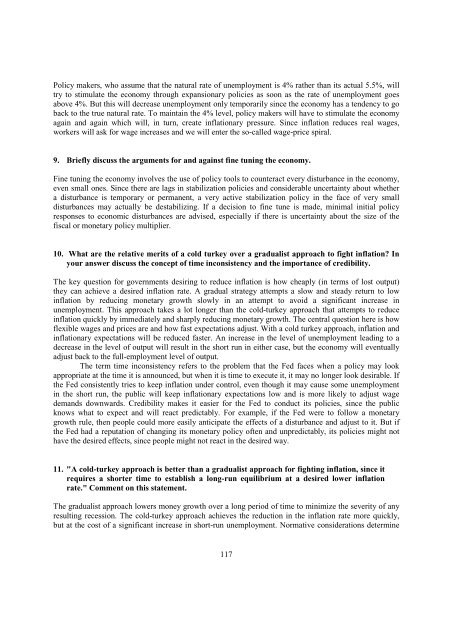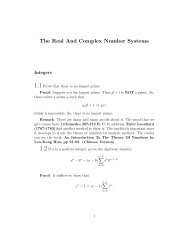Fiscal and monetary policy lags ⢠Automatic stabilizers ...
Fiscal and monetary policy lags ⢠Automatic stabilizers ...
Fiscal and monetary policy lags ⢠Automatic stabilizers ...
Create successful ePaper yourself
Turn your PDF publications into a flip-book with our unique Google optimized e-Paper software.
Policy makers, who assume that the natural rate of unemployment is 4% rather than its actual 5.5%, willtry to stimulate the economy through expansionary policies as soon as the rate of unemployment goesabove 4%. But this will decrease unemployment only temporarily since the economy has a tendency to goback to the true natural rate. To maintain the 4% level, <strong>policy</strong> makers will have to stimulate the economyagain <strong>and</strong> again which will, in turn, create inflationary pressure. Since inflation reduces real wages,workers will ask for wage increases <strong>and</strong> we will enter the so-called wage-price spiral.9. Briefly discuss the arguments for <strong>and</strong> against fine tuning the economy.Fine tuning the economy involves the use of <strong>policy</strong> tools to counteract every disturbance in the economy,even small ones. Since there are <strong>lags</strong> in stabilization policies <strong>and</strong> considerable uncertainty about whethera disturbance is temporary or permanent, a very active stabilization <strong>policy</strong> in the face of very smalldisturbances may actually be destabilizing. If a decision to fine tune is made, minimal initial <strong>policy</strong>responses to economic disturbances are advised, especially if there is uncertainty about the size of thefiscal or <strong>monetary</strong> <strong>policy</strong> multiplier.10. What are the relative merits of a cold turkey over a gradualist approach to fight inflation? Inyour answer discuss the concept of time inconsistency <strong>and</strong> the importance of credibility.The key question for governments desiring to reduce inflation is how cheaply (in terms of lost output)they can achieve a desired inflation rate. A gradual strategy attempts a slow <strong>and</strong> steady return to lowinflation by reducing <strong>monetary</strong> growth slowly in an attempt to avoid a significant increase inunemployment. This approach takes a lot longer than the cold-turkey approach that attempts to reduceinflation quickly by immediately <strong>and</strong> sharply reducing <strong>monetary</strong> growth. The central question here is howflexible wages <strong>and</strong> prices are <strong>and</strong> how fast expectations adjust. With a cold turkey approach, inflation <strong>and</strong>inflationary expectations will be reduced faster. An increase in the level of unemployment leading to adecrease in the level of output will result in the short run in either case, but the economy will eventuallyadjust back to the full-employment level of output.The term time inconsistency refers to the problem that the Fed faces when a <strong>policy</strong> may lookappropriate at the time it is announced, but when it is time to execute it, it may no longer look desirable. Ifthe Fed consistently tries to keep inflation under control, even though it may cause some unemploymentin the short run, the public will keep inflationary expectations low <strong>and</strong> is more likely to adjust wagedem<strong>and</strong>s downwards. Credibility makes it easier for the Fed to conduct its policies, since the publicknows what to expect <strong>and</strong> will react predictably. For example, if the Fed were to follow a <strong>monetary</strong>growth rule, then people could more easily anticipate the effects of a disturbance <strong>and</strong> adjust to it. But ifthe Fed had a reputation of changing its <strong>monetary</strong> <strong>policy</strong> often <strong>and</strong> unpredictably, its policies might nothave the desired effects, since people might not react in the desired way.11. "A cold-turkey approach is better than a gradualist approach for fighting inflation, since itrequires a shorter time to establish a long-run equilibrium at a desired lower inflationrate." Comment on this statement.The gradualist approach lowers money growth over a long period of time to minimize the severity of anyresulting recession. The cold-turkey approach achieves the reduction in the inflation rate more quickly,but at the cost of a significant increase in short-run unemployment. Normative considerations determine117
















